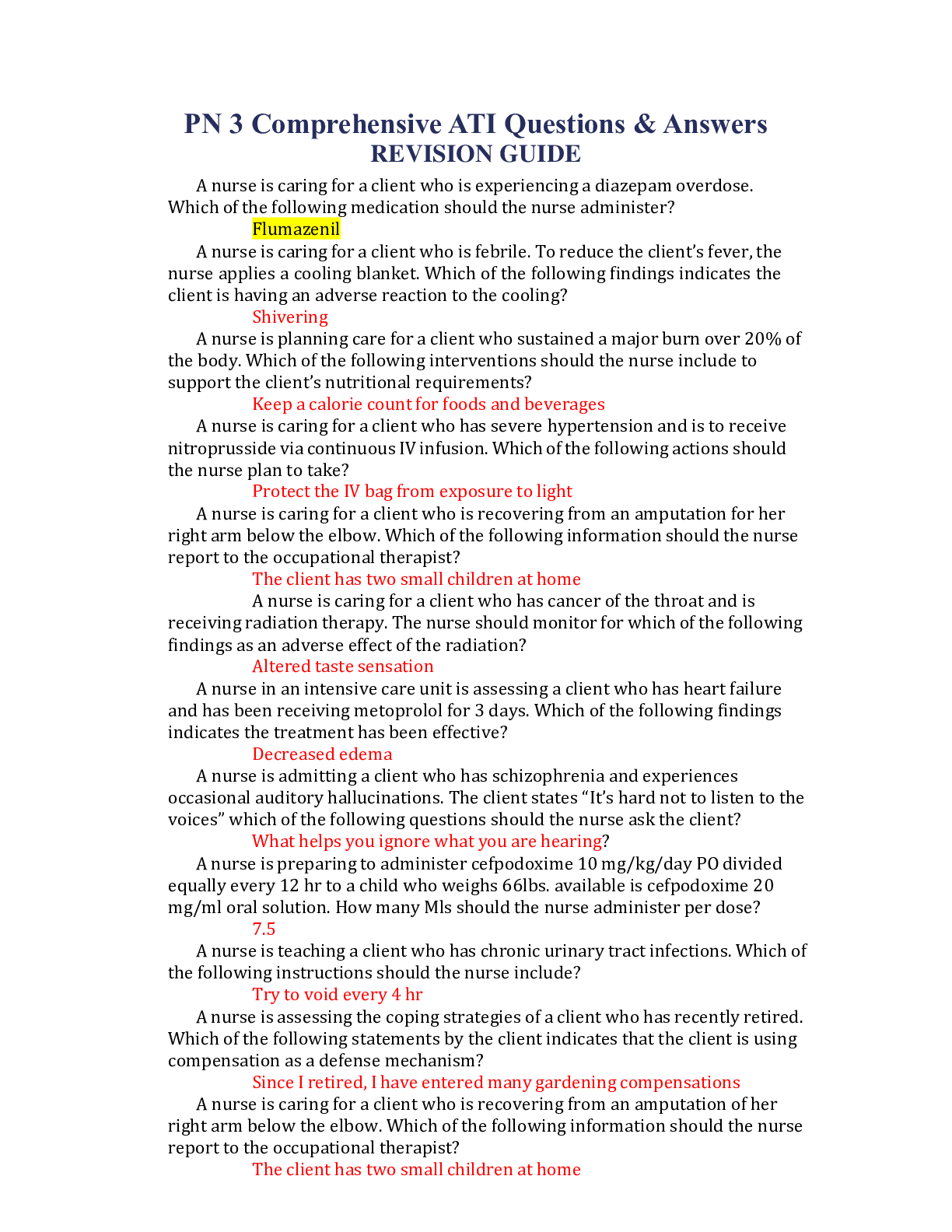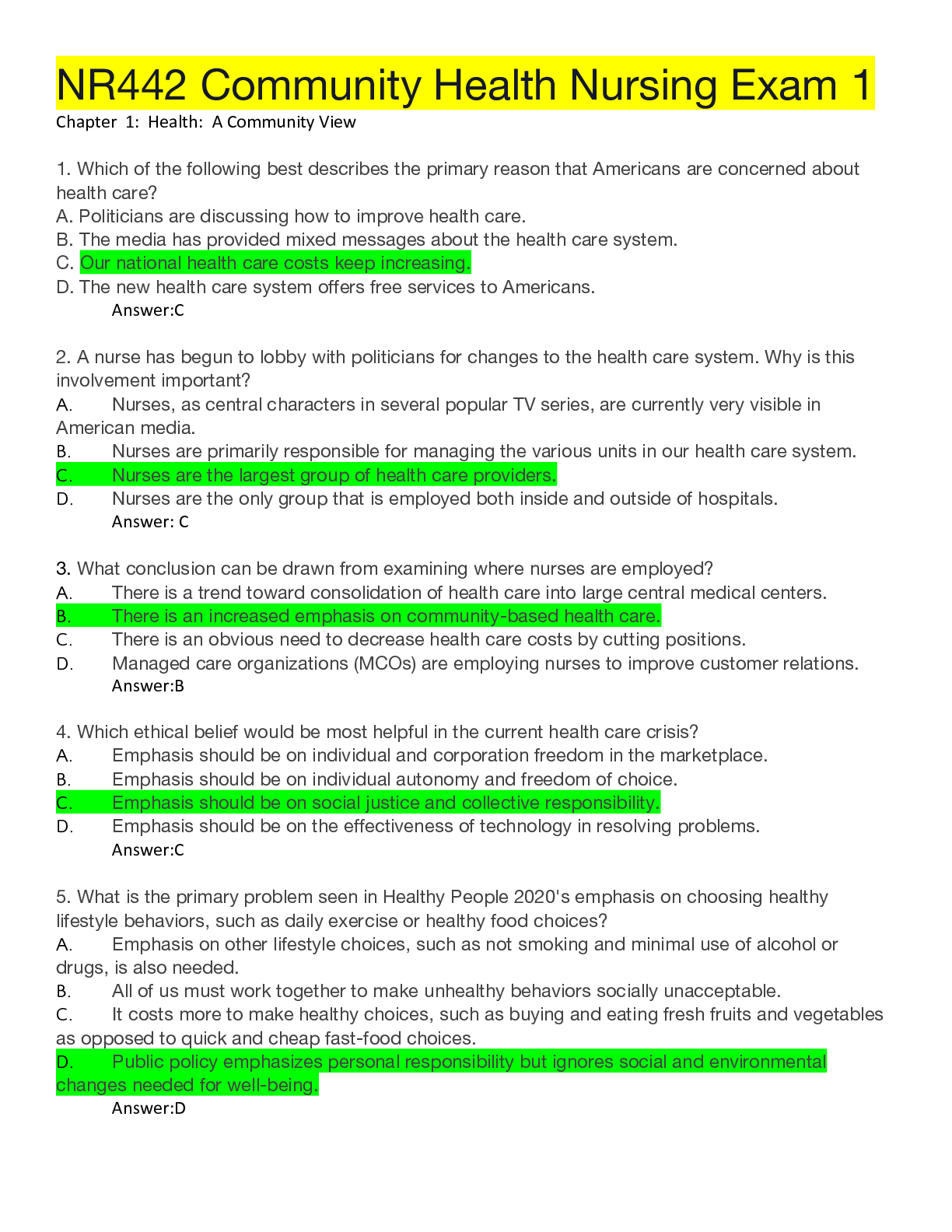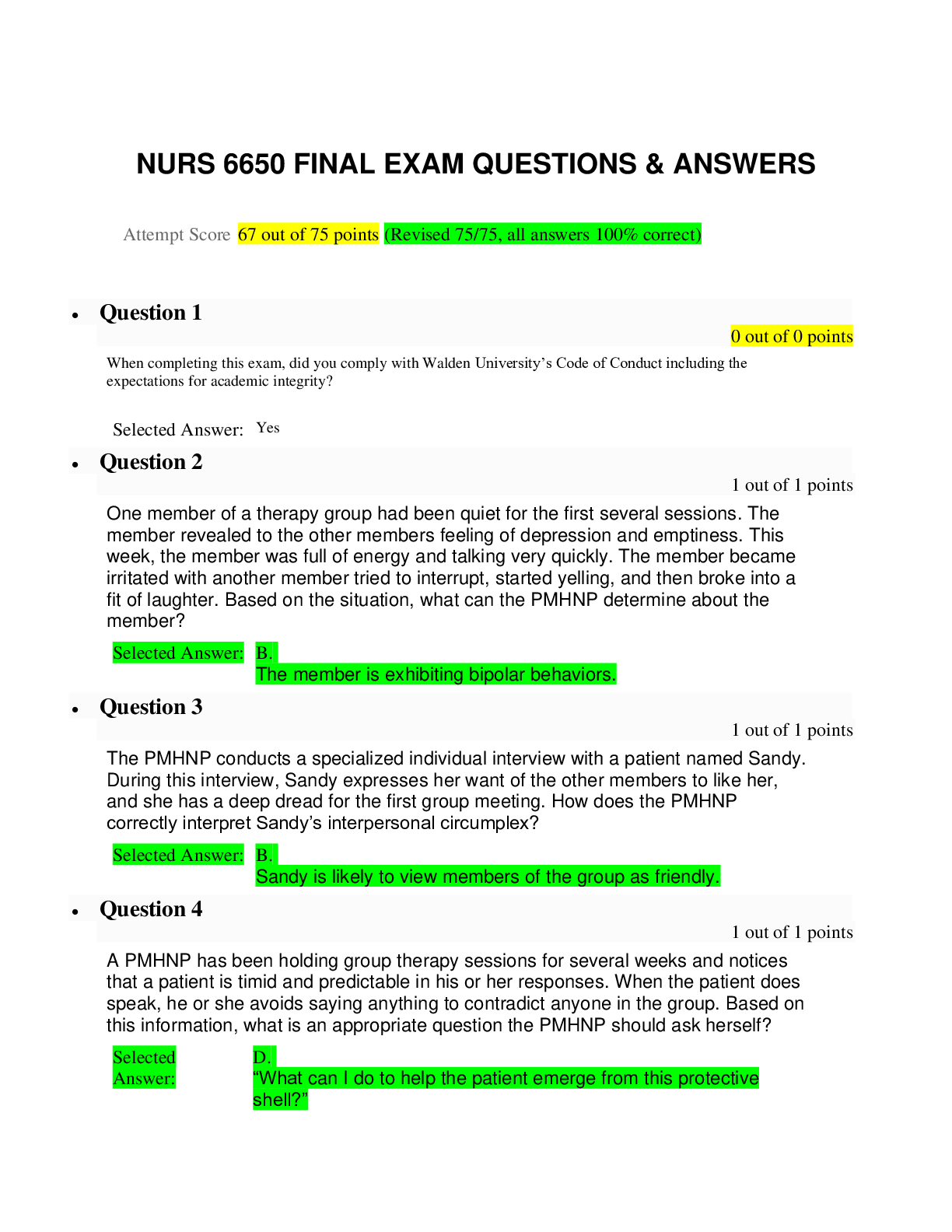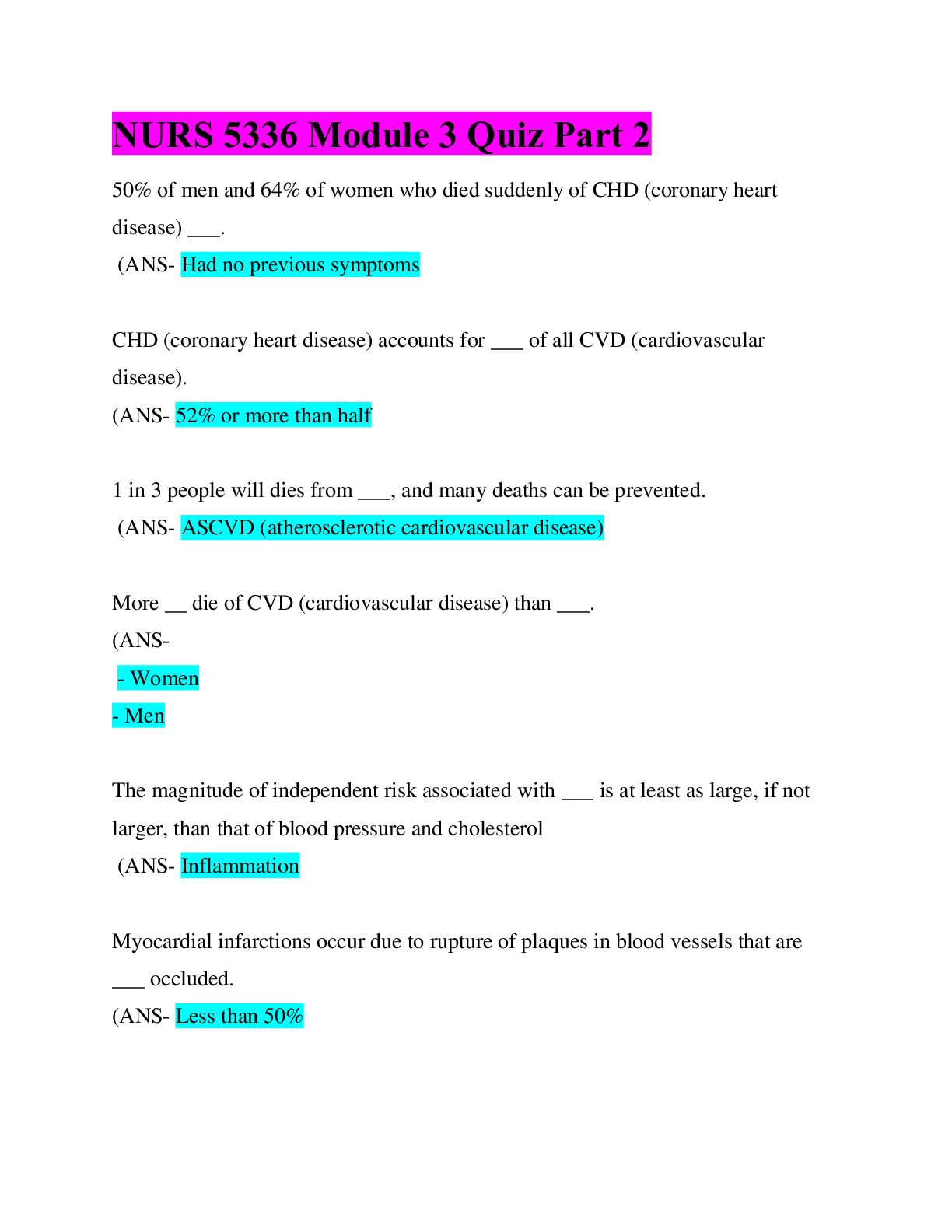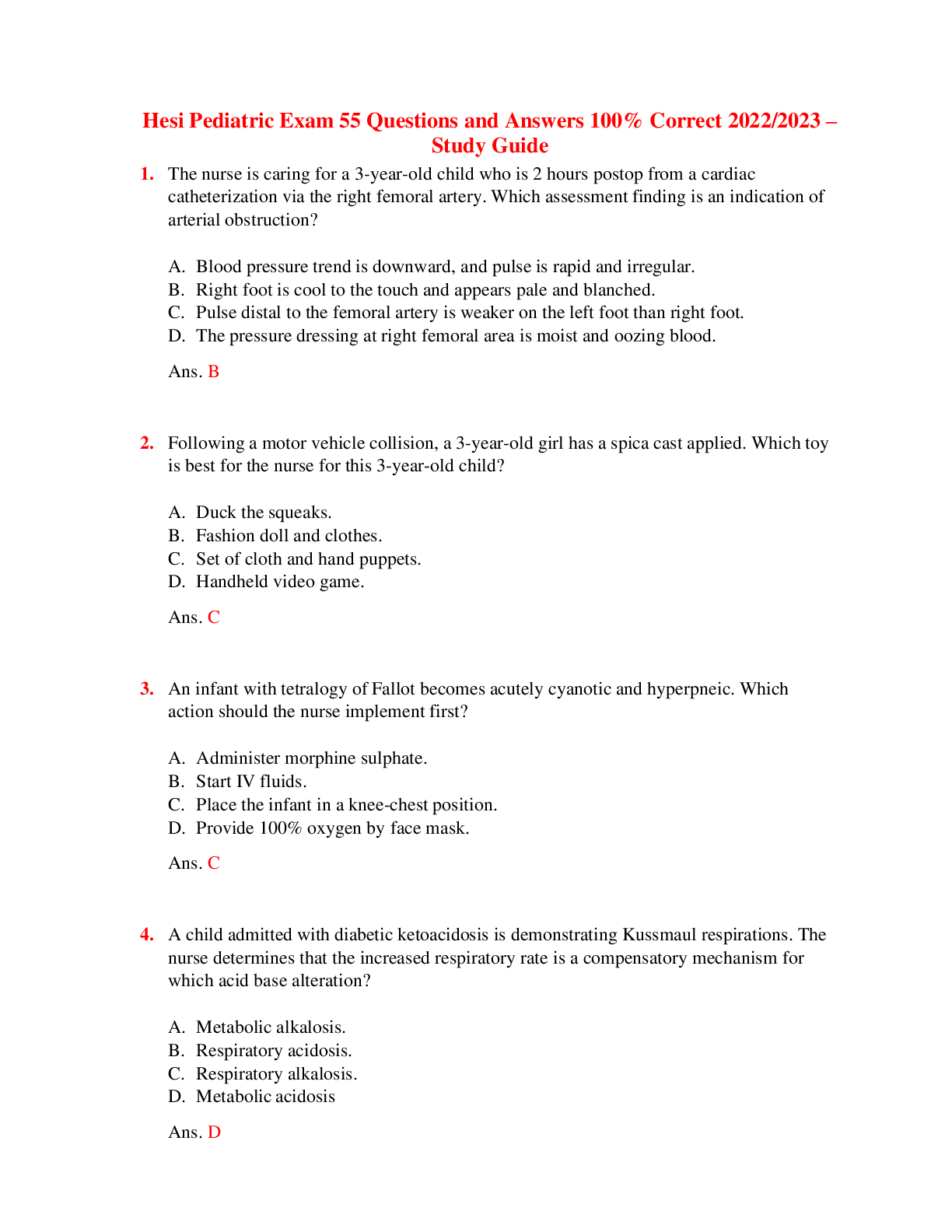NURSING. > EXAM > FOUNDATIONS AND ADULT HEALTH NURSING 9TH EDITION COOPER GOSNELL TEST BANK QUESTIONS & ANSWERS WITH R (All)
FOUNDATIONS AND ADULT HEALTH NURSING 9TH EDITION COOPER GOSNELL TEST BANK QUESTIONS & ANSWERS WITH RATIONALES 2023
Document Content and Description Below
FOUNDATIONS AND ADULT HEALTH NURSING 9TH EDITION COOPER GOSNELL TEST BANK QUESTIONS & ANSWERS WITH RATIONALES 2023 Chapter 01: The Evolution of Nursing Cooper: Foundation of Nursing, 9th Editio... n MULTIPLE CHOICE 1. What is a nursing program considered when certified by a state agency? a. Accredited b. Approved c. Provisional d. Exemplified ANS: B Approved means certified by a state agency for having met minimum standards; accredited means certified by the NLN for having met more complex standards. Provisional and exemplified are not terms used in regard to nursing program certification. DIF: Cognitive Level: Knowledge REF: p. 10 OBJ: 5 TOP: Nursing programs KEY: Nursing Process Step: N/A MSC: NCLEX: N/A 2. Which of the following must the nurse recognize regarding the health care delivery system? a. It includes all states. b. It affects the illness of patients. c. Insurance companies are not involved. d. The major goal is to achieve optimal levels of health care. ANS: D The nurse must recognize that in the health care delivery system, the major goal is to achieve optimal levels of health care. The health care system consists of a network of agencies, facilities, and providers involved with health care in a specified geographic area. Insurance companies do have involvement in the health care system. The illness of patients is not necessarily affected by the health care system. DIF: Cognitive Level: Comprehension REF: p. 12 OBJ: 7 TOP: Health care systems KEY: Nursing Process Step: N/A MSC: NCLEX: N/A 3. What is required by the health care team to identify the needs of a patient and to design care to meet those needs? a. The Kardex b. The health care provider's order sheet c. An individualized care plan d. The nurse's notes ANS: C An individualized care plan involves all health care workers and outlines care to meet the needs of the individual patient. The Kardex, health care provider's order sheet, and nurse's notes do not identify the needs of the patient nor are they designed to assist all members of the health care team to meet those needs. DIF: Cognitive Level: Comprehension REF: p. 13 OBJ: 8 | 9 TOP: Care plan KEY: Nursing Process Step: Planning MSC: NCLEX: N/A 4. Patient care emphasis on wellness, rather than illness, begins as a result of: a. increased education concerning causes of illness. b. improved insurance payments. c. decentralized care centers. d. increased number of health care givers. ANS: A The acute awareness of preventive medicine has resulted in today's emphasis on education about issues such as smoking, heart disease, drug and alcohol abuse, weight control, and mental health and wellness promotion activities. This preventive education has resulted in an emphasis on wellness, rather than illness. Improved insurance payments, decentralized care centers, and increased numbers of health care givers did not influence an emphasis on wellness. DIF: Cognitive Level: Comprehension REF: p. 12 OBJ: 4 | 8 TOP: Wellness KEY: Nursing Process Step: N/A MSC: NCLEX: N/A 5. What is the most effective process to ensure that the care plan is meeting the needs of the patient? a. Documentation b. Communication c. Evaluation d. Planning ANS: B Communication is the primary essential component among the health care team to evaluate and modify the care plan. Documentation, evaluation, and planning are not primary essential components to ensure the care plan is meeting the needs of the patient. DIF: Cognitive Level: Comprehension REF: p. 17 OBJ: 8 TOP: Communication KEY: Nursing Process Step: N/A MSC: NCLEX: N/A 6. How does an interdisciplinary approach to patient treatment enhance care? a. By improving efficiency of care b. By reducing the number of caregivers c. By preventing the fragmentation of patient care d. By shortening hospital stay ANS: C An interdisciplinary approach prevents fragmentation of care. An interdisciplinary approach does not improve the efficiency of care, reduce the number of caregivers, or shorten hospital stay. DIF: Cognitive Level: Comprehension REF: p. 16 OBJ: 8 | 9 TOP: Interdisciplinary approach KEY: Nursing Process Step: N/A MSC: NCLEX: N/A 7. How may a newly licensed LPN/LVN practice? a. Independently in a hospital setting b. With an experienced LPN/LVN c. Under the supervision of a health care provider or RN d. As a sole health care provider in a clinic setting ANS: C An LPN/LVN practices under the supervision of a health care provider, dentist, OD, or RN. DIF: Cognitive Level: Knowledge REF: p. 11 OBJ: 11 TOP: Vocational nursing KEY: Nursing Process Step: N/A MSC: NCLEX: N/A 8. Whose influence on nursing practice in the 19th century was related to improvement of patient environment as a method of health promotion? a. Clara Barton b. Linda Richards c. Dorothea Dix d. Florence Nightingale ANS: D The influence of Florence Nightingale was highly significant in the 19th century as she fought for sanitary conditions, fresh air, and general improvement in the patient environment. Clara Barton developed the American Red Cross in 1881. Linda Richards is known as the first trained nurse in America, was responsible for the development of the first nursing and hospital records, and is credited with the development of our present-day documentation system. Dorothea Dix was the pioneer crusader for elevation of standards of care for the mentally ill and superintendent of female nurses of the Union Army. DIF: Cognitive Level: Knowledge REF: p. 17 OBJ: 2 | 4 TOP: Nursing leaders KEY: Nursing Process Step: N/A MSC: NCLEX: N/A 9. What document identifies the roles and responsibilities of the LPN/LVN? a. NLN Accreditation Standards b. Nurse Practice Act c. NAPNE Code d. American Nurses' Association Code ANS: B The LPN/LVN functions under the Nurse Practice Act. NLN Accreditation Standards, the NAPNE Code, and the American Nurses' Association Code do not identify the roles and responsibilities of the LPN/LVN. DIF: Cognitive Level: Knowledge REF: p. 12 | p. 14 OBJ: 11 TOP: Roles and responsibilities KEY: Nursing Process Step: N/A MSC: NCLEX: N/A 10. What is a cost-effective delivery of care used by many hospitals that allows the LPN/LVN to work with the RN to meet the needs of patients? a. Focused nursing b. Team nursing c. Case management d. Primary nursing ANS: C Case management is a cost-effective method of care. Focused nursing, team nursing, and primary nursing are not cost-effective methods of delivering care that allow the LPN/LVN to work with the RN to meet patient needs. DIF: Cognitive Level: Comprehension REF: p. 15 OBJ: 7 | 9 TOP: Patient care delivery systems KEY: Nursing Process Step: N/A MSC: NCLEX: N/A 11. What is the title of the American Hospital Association's 1972 document that outlines the patient's expectations to be treated with dignity and compassion? a. Code of Ethics b. Patient's Bill of Rights c. OBRA d. Advance directives ANS: B Patient expectations are outlined by the Patient's Bill of Rights. Patient expectations are not outlined in the Code of Ethics, OBRA, or advance directives. DIF: Cognitive Level: Knowledge REF: p. 16 OBJ: 4 | 8 TOP: Patient's rights KEY: Nursing Process Step: N/A MSC: NCLEX: N/A 12. The relationships among nursing, patients, health, and the environment are the basis for: a. care plans. b. nursing models. c. health care provider's orders. d. evaluation of patient care. ANS: B Nursing models are theories based on the relationship between nursing, patients, health, and environment. Care plans, health care provider's orders, and evaluation of patient care are not based on the relationships among nursing, patients, health, and environment. DIF: Cognitive Level: Comprehension REF: p. 17 OBJ: 1 TOP: Nursing models KEY: Nursing Process Step: N/A MSC: NCLEX: N/A 13. What system reduces the number of employees but still provides quality care for patients? a. Team nursing b. Cross-training c. Use of critical pathways d. Case management ANS: B Cross-training reduces the number of employees but does not alter the quality of patient care. Team nursing, use of critical pathways, and case management do not reduce the number of employees while continuing to provide quality care for patients. DIF: Cognitive Level: Comprehension REF: p. 15 OBJ: 8 TOP: Patient care KEY: Nursing Process Step: N/A MSC: NCLEX: N/A 14. What is the purpose of licensing laws for LPN/LVNs? a. To limit the number of LPN/LVNs b. Prevention of malpractice c. Protection of the public from unqualified people d. To increase revenue for the state board of nursing ANS: C The purpose of licensing laws for LPN/LVNs is to protect the public from unqualified health care providers. Licensing laws' purpose is not to limit the number of LPNs/LVNs, prevent malpractice, or increase revenue for the state board of nursing. DIF: Cognitive Level: Comprehension REF: p. 11 OBJ: 4 | 9 | 10 TOP: Licensure KEY: Nursing Process Step: N/A MSC: NCLEX: N/A 15. What premise is Maslow's hierarchy of needs based on? a. All needs are equally important. b. Basic needs must be met before the next level of needs can be met. c. Self-actualization is a primary need. d. Individuals prioritize needs the same way. ANS: B Maslow's hierarchy of needs is based on the premise that basic needs must be met first. It is not based on all needs being equally important or that individuals prioritize needs the same way. Self-actualization is not a primary need according to Maslow. DIF: Cognitive Level: Comprehension REF: p. 12 | p. 13 OBJ: 8 TOP: Maslow's Hierarchy of Needs KEY: Nursing Process Step: N/A MSC: NCLEX: N/A 16. What must the nurse realize when assessing physical and social environmental factors affecting health and illness? a. They affect one another. b. They cause illness. c. They cause patients to react similarly. d. They can be separated. ANS: A Physical and social factors affect each other, cannot be separated, and cause each patient to react in a unique manner. They do not necessarily cause illness or cause patients to react similarly, and they cannot be separated. DIF: Cognitive Level: Comprehension REF: p. 14 OBJ: 4 | 8 TOP: Environmental factors KEY: Nursing Process Step: Assessment MSC: NCLEX: Health Promotion and Maintenance 17. What organization, established during World War II, provided nursing education and training? a. Nightingale school b. Cadet Nurse Corps c. Public health department d. Frontier Nursing Service [Show More]
Last updated: 6 months ago
Preview 1 out of 850 pages
Instant download
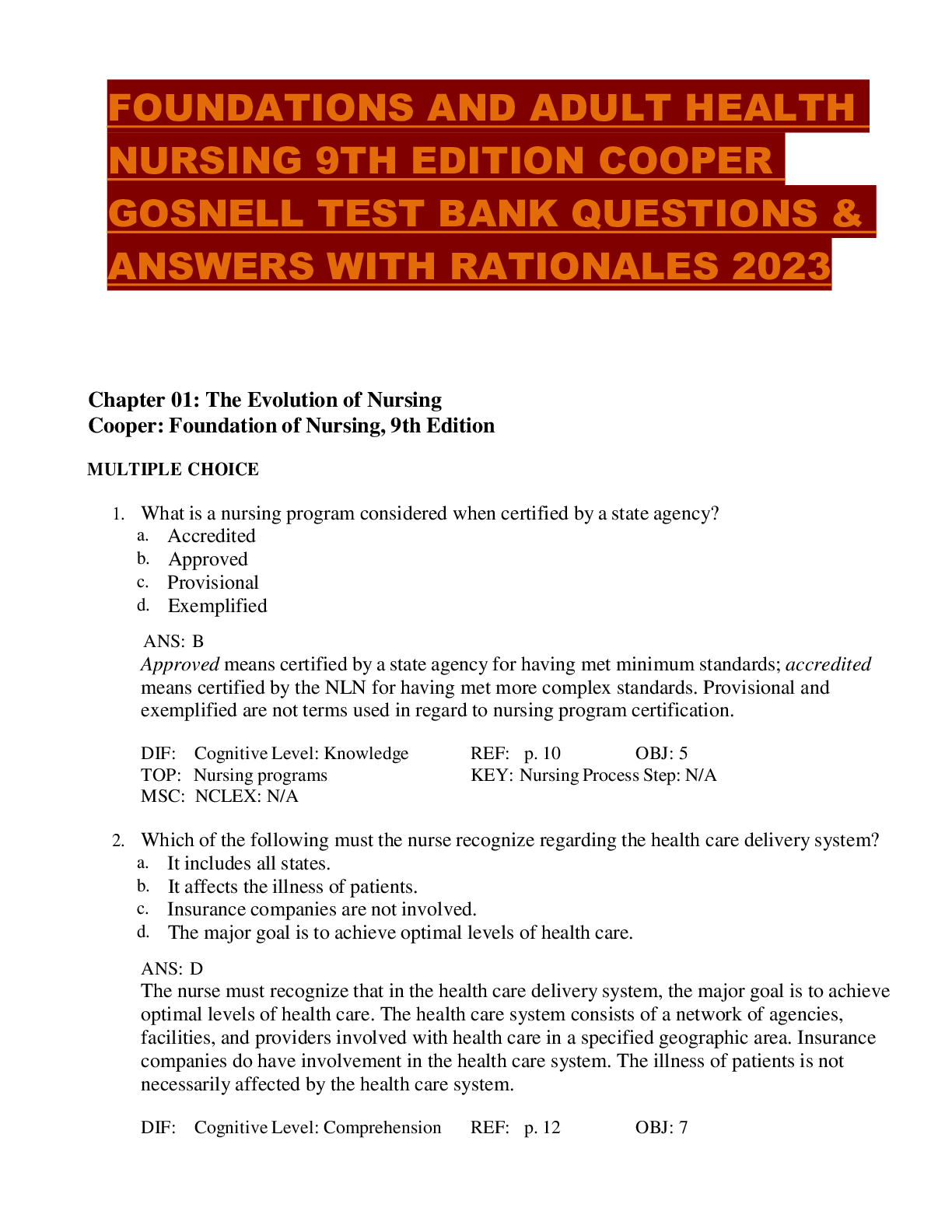
Instant download
Reviews( 0 )
Document information
Connected school, study & course
About the document
Uploaded On
Nov 15, 2023
Number of pages
850
Written in
Additional information
This document has been written for:
Uploaded
Nov 15, 2023
Downloads
0
Views
93

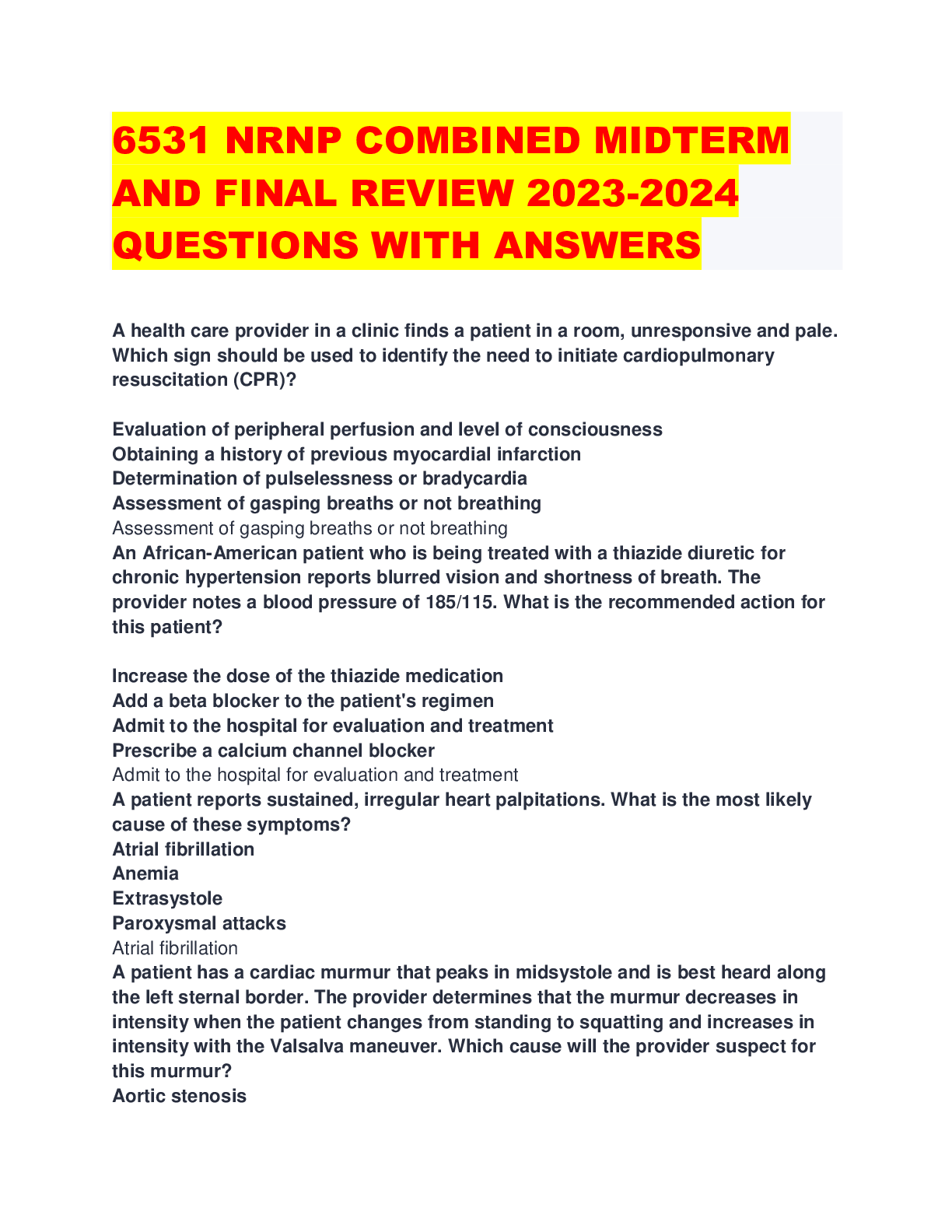
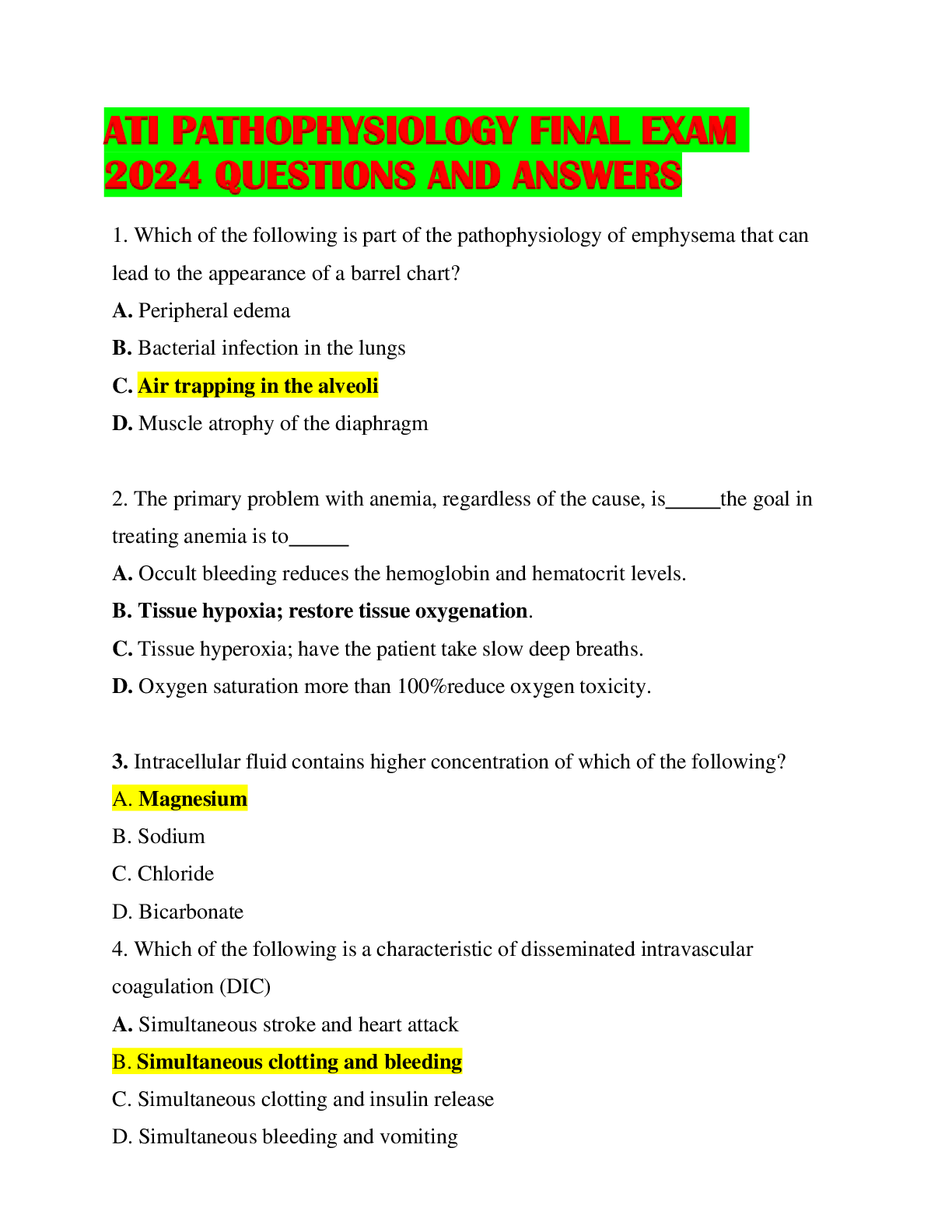


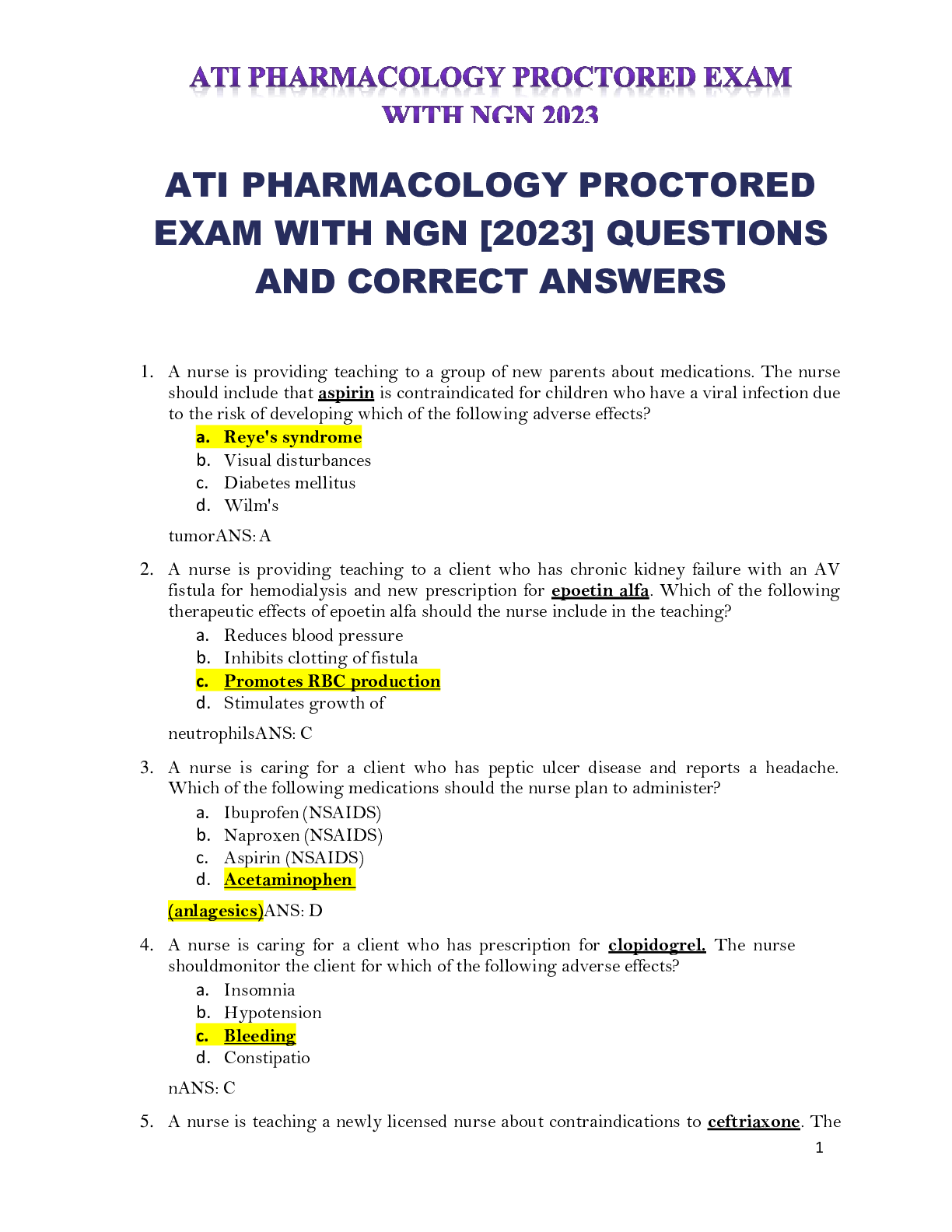
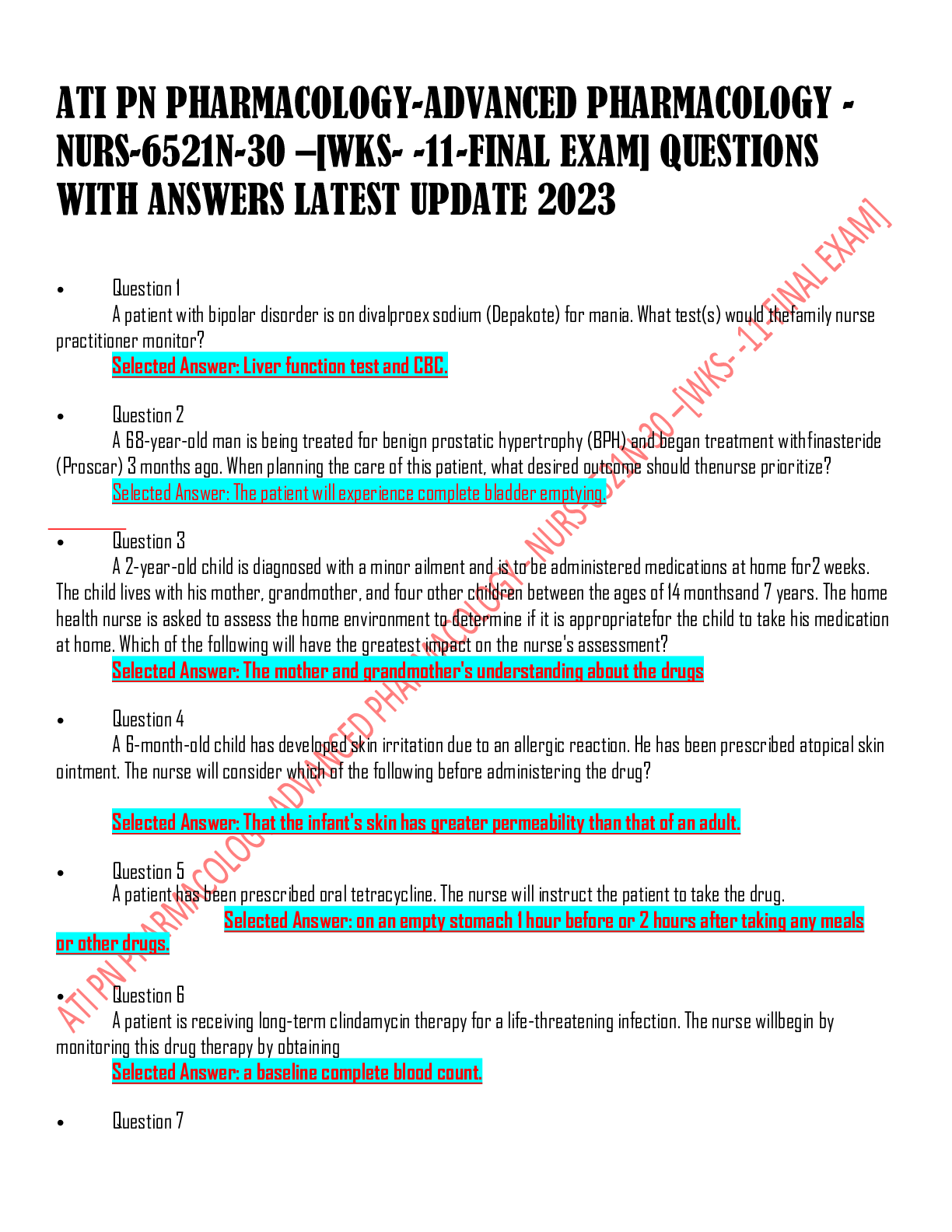




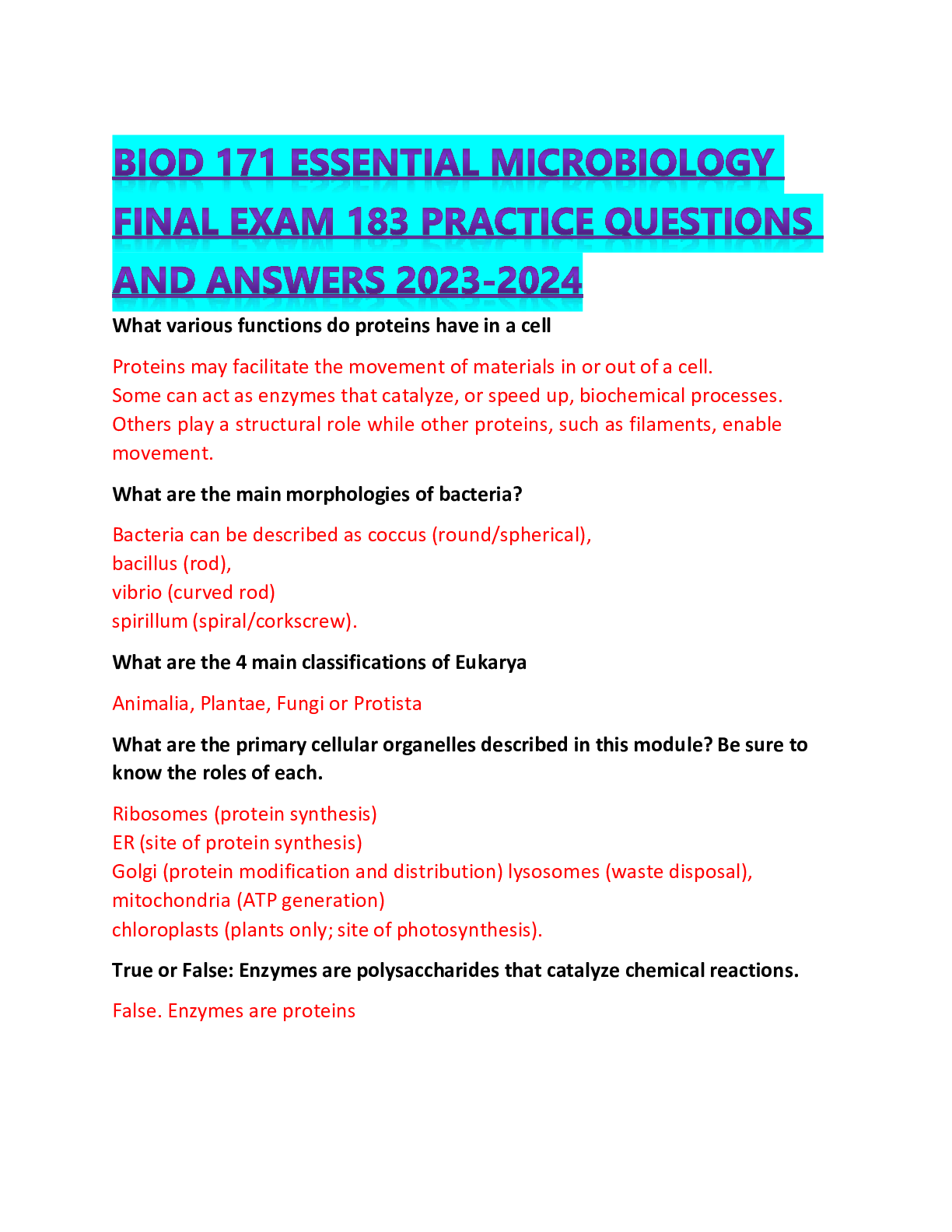
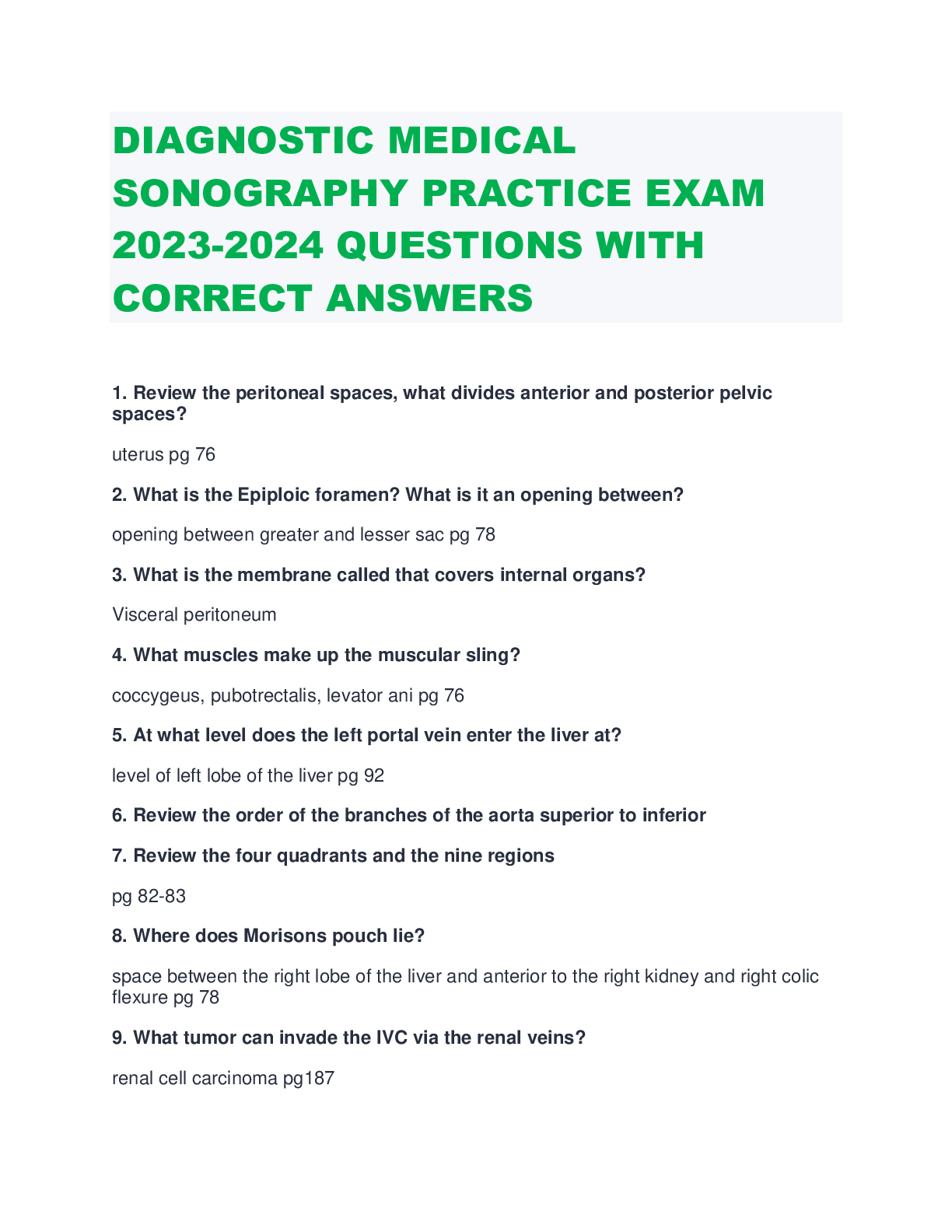
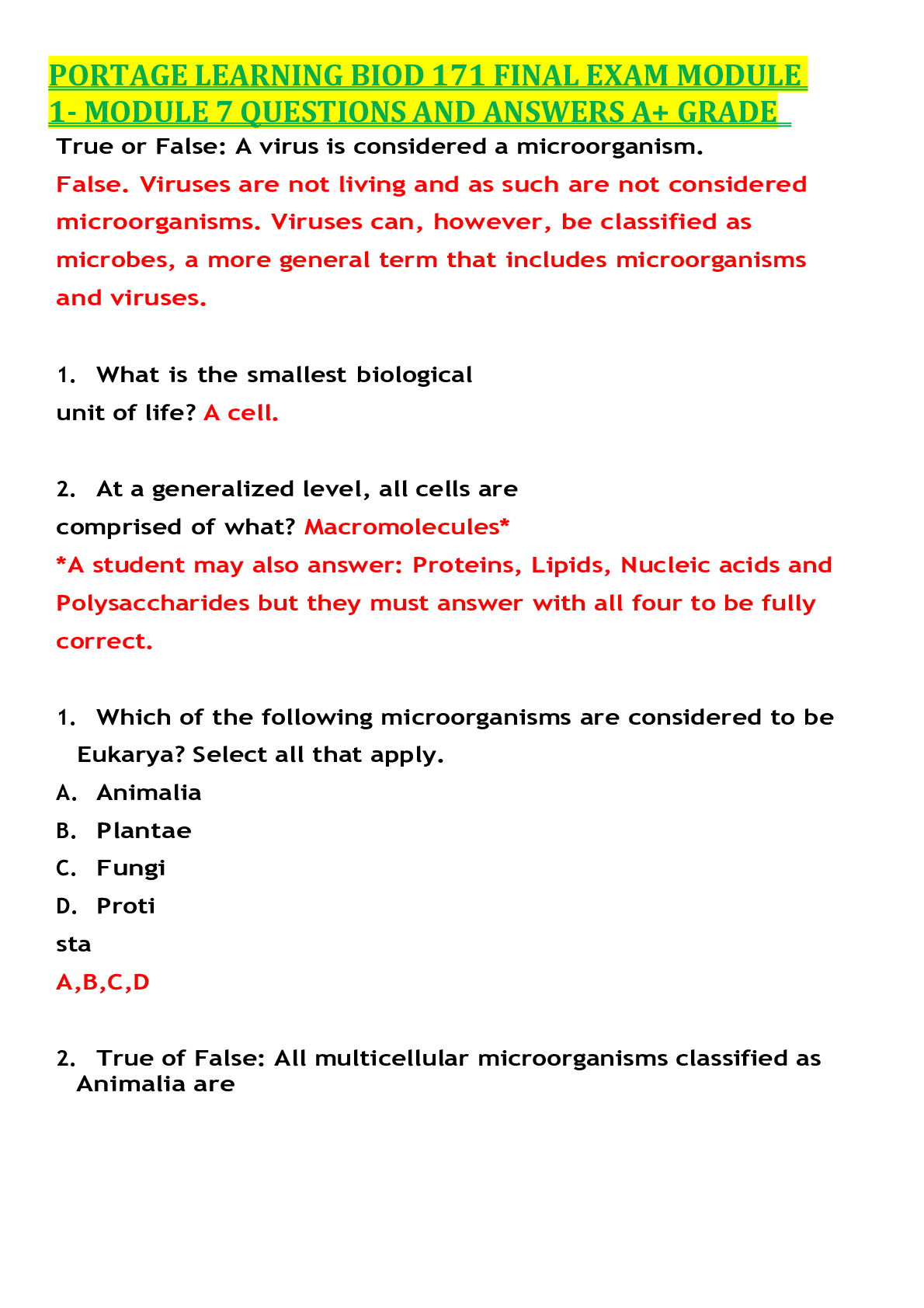
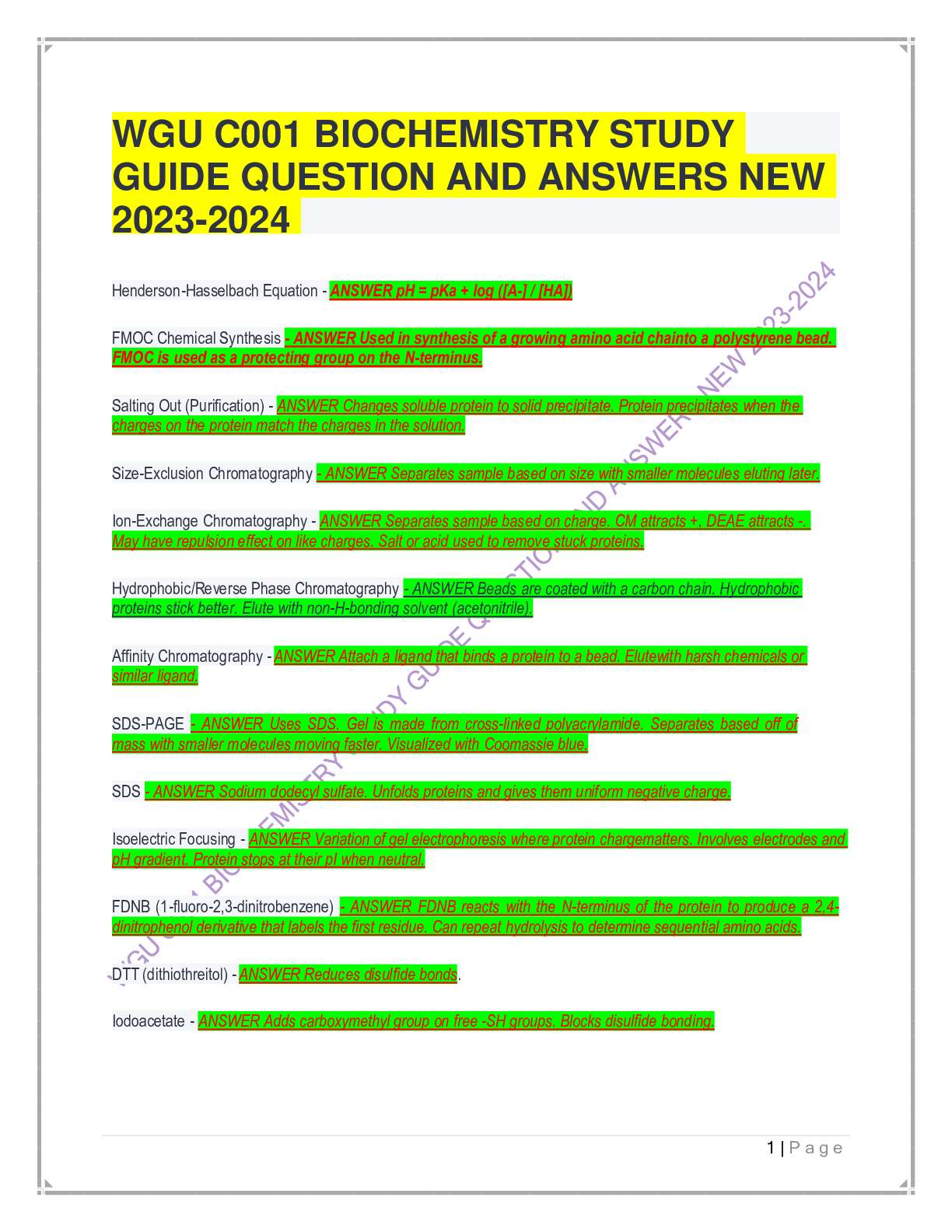

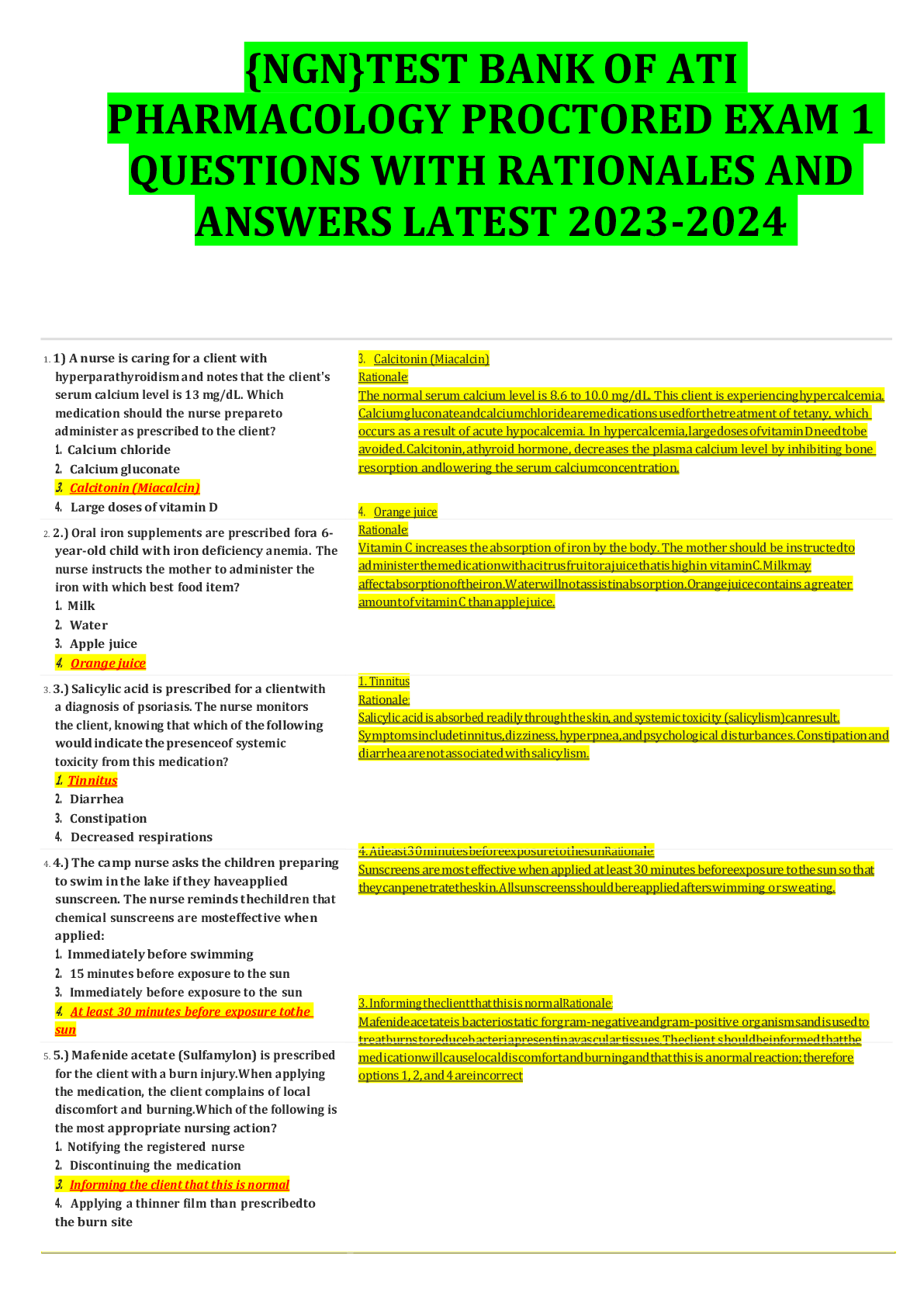
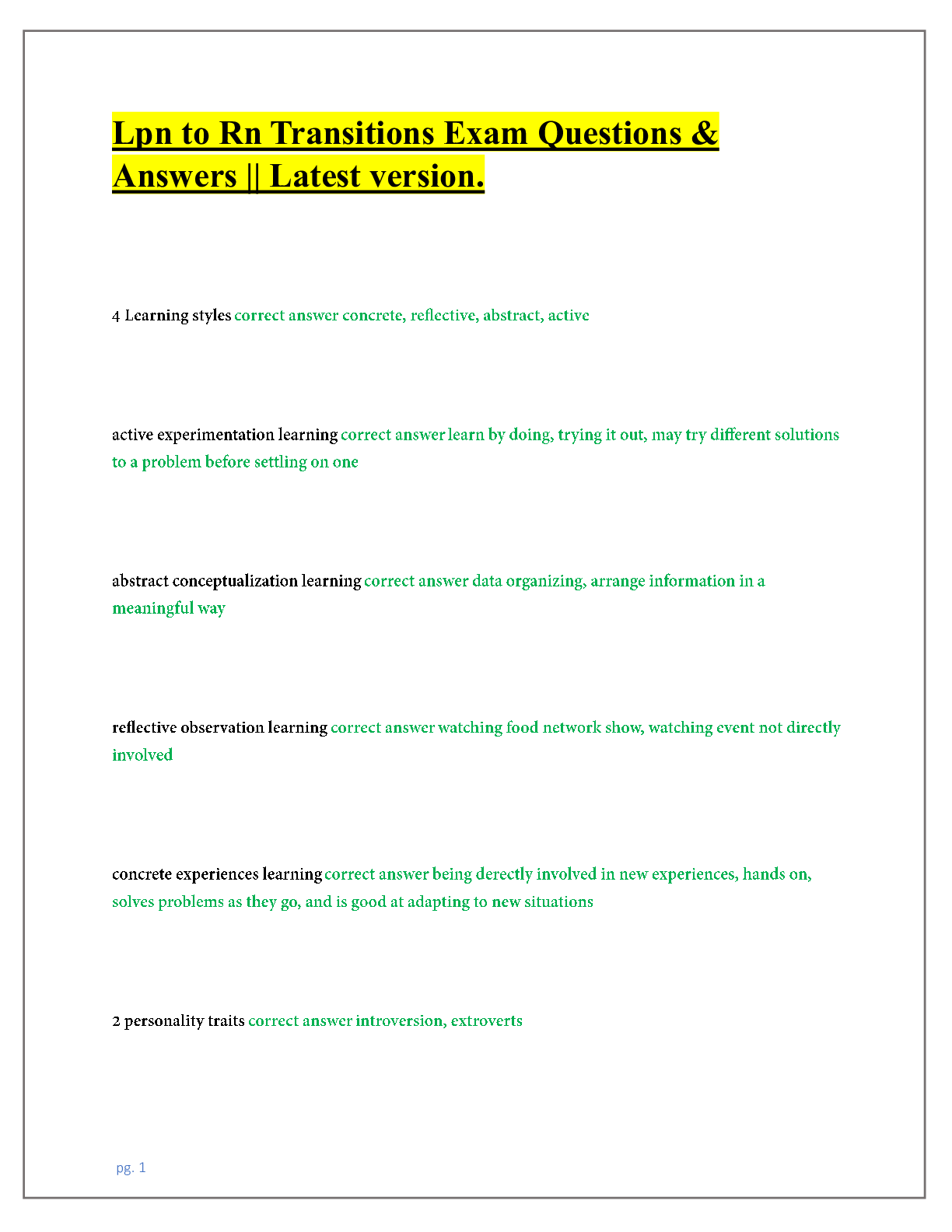
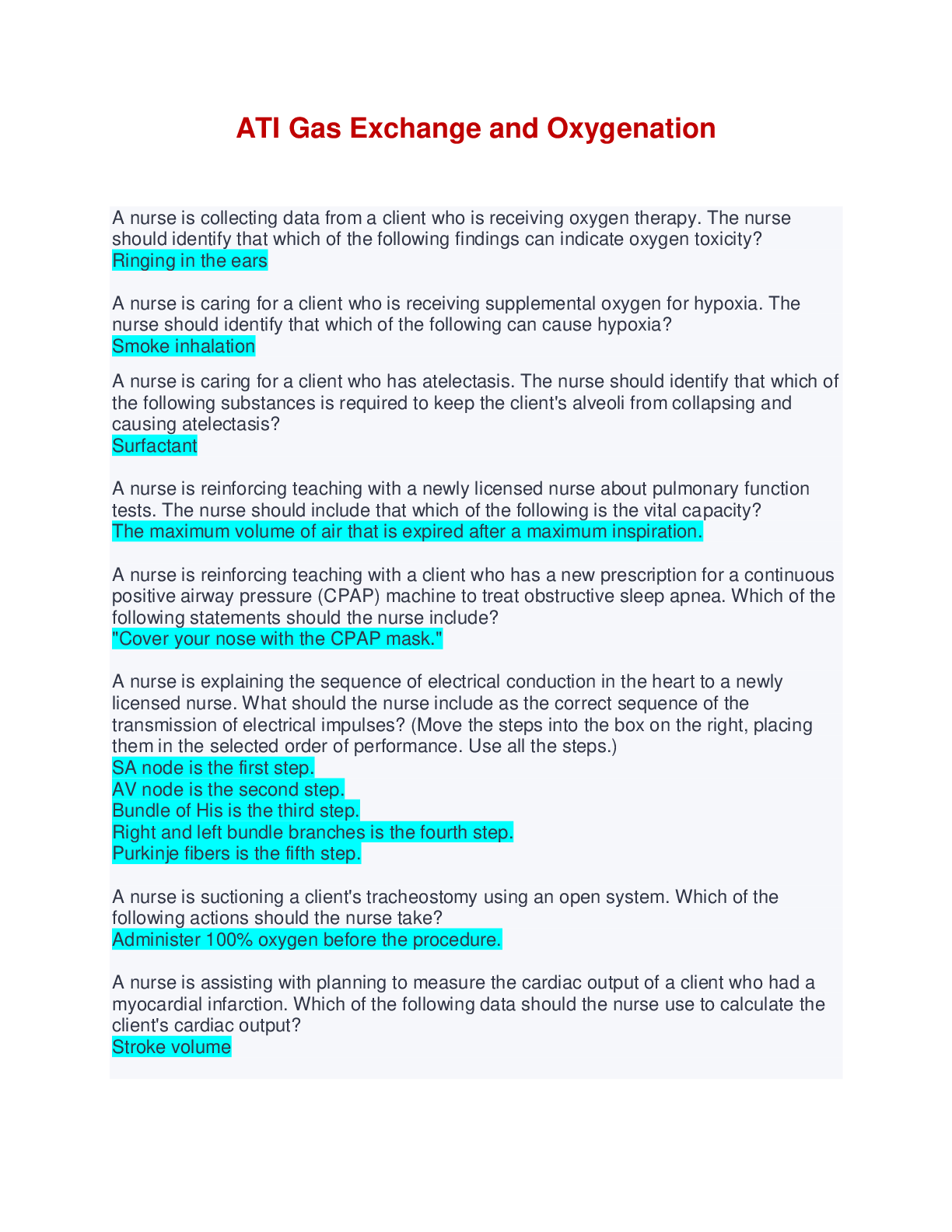
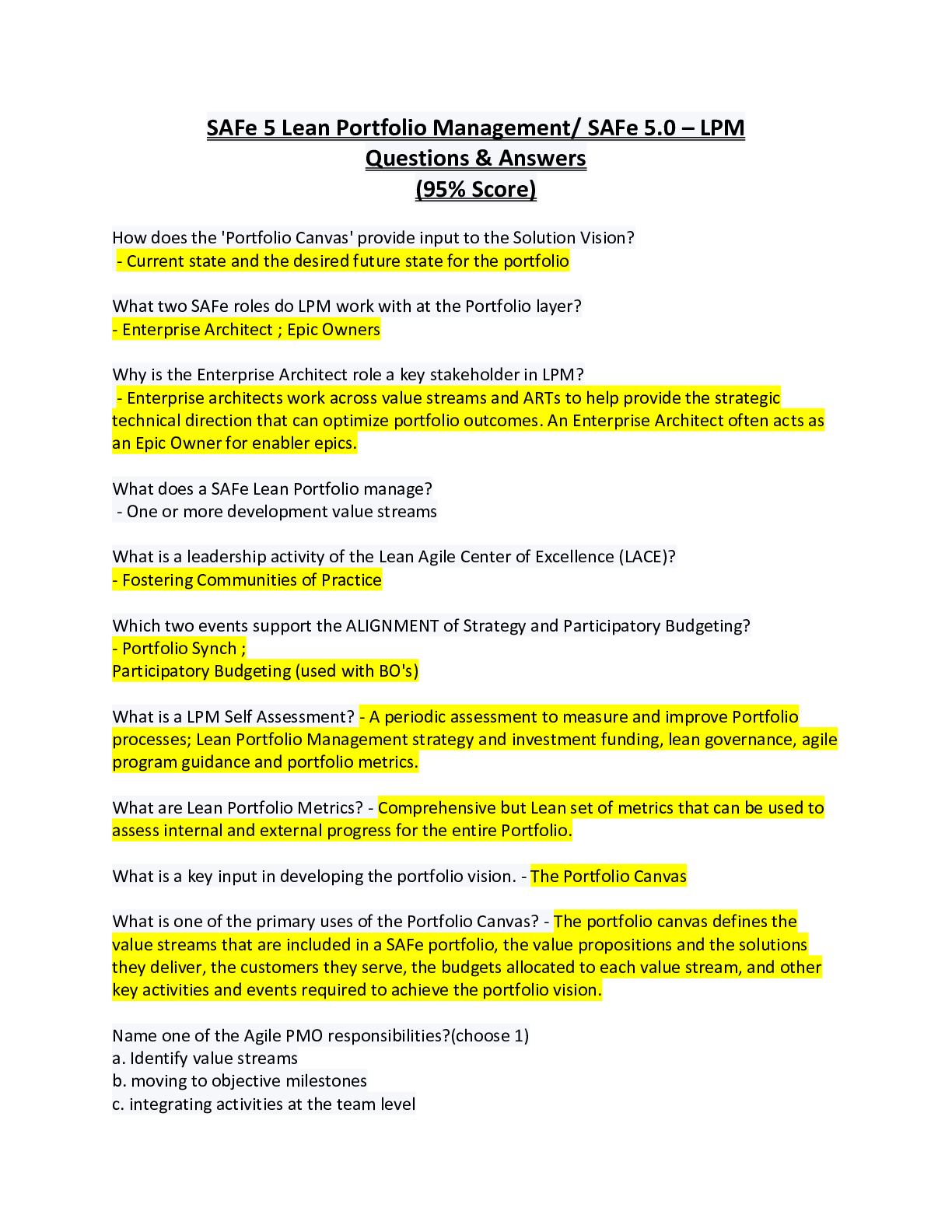




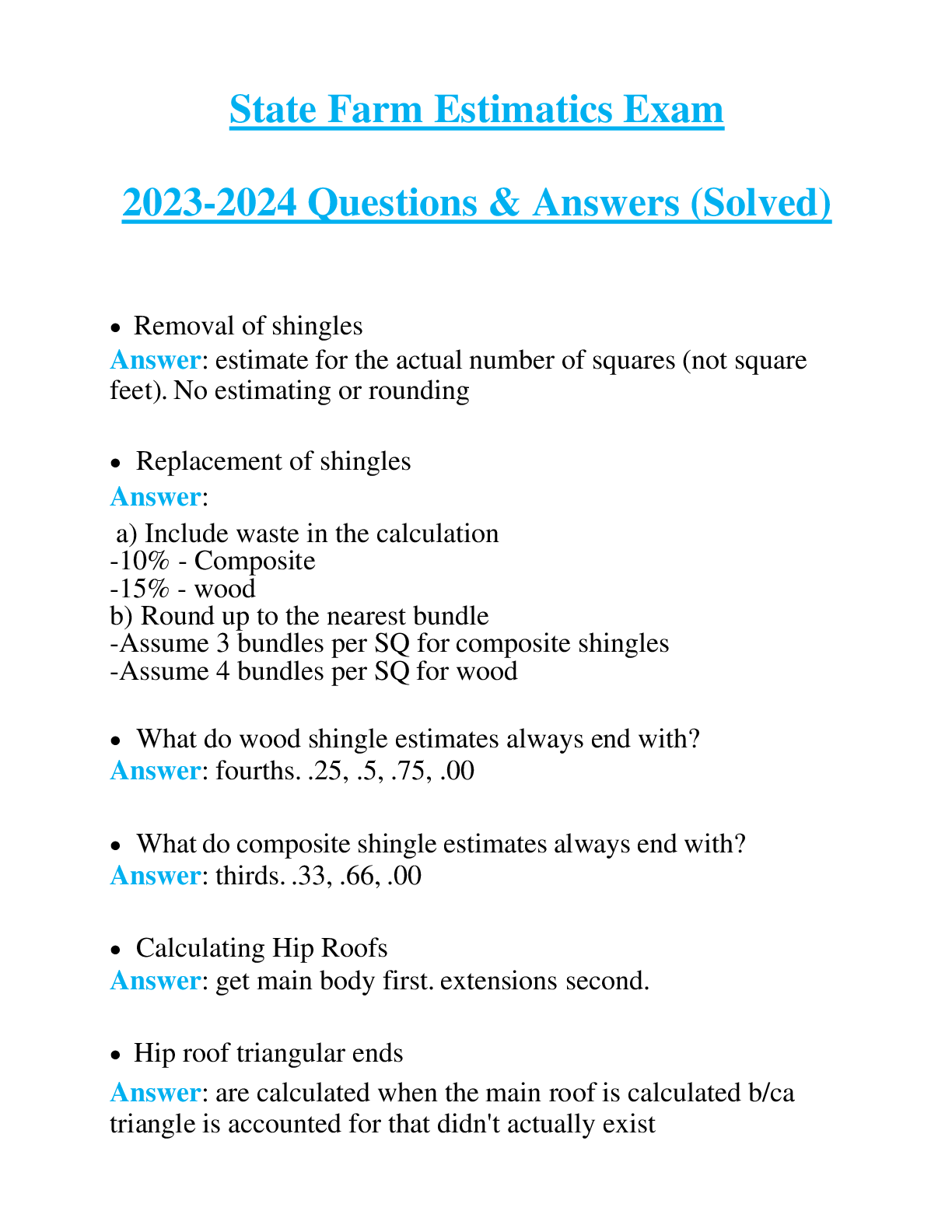
.png)



